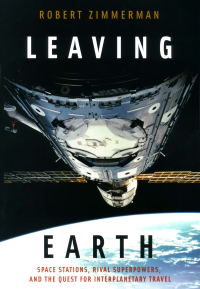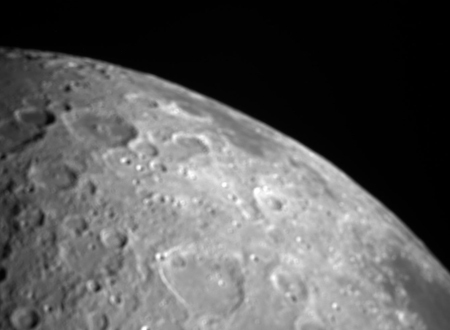Webb and Chandra take composite X-ray/infrared images of four famous objects
Astronomers have now used the Chandra X-ray Observatory and Webb Space Telescope (working in the infrared) to produce spectacular composite false-color X-ray/infrared images of four famous heavenly objects.
To the right is the composite taken of the Eagle Nebula, also known as Messier 16. It was also dubbed the Pillars of Creation when it was one of the first Hubble images taken after the telescope’s mirror focus was fixed in 1993. From the caption:
The Webb image shows the dark columns of gas and dust shrouding the few remaining fledgling stars just being formed. The Chandra sources, which look like dots, are young stars that give off copious amounts of X-rays. (X-ray: red, blue; infrared: red, green, blue)
The other images include star cluster NGC 346 in a nearby galaxy, the spiral galaxy NGC 1672, and the face-on spiral galaxy Messier 74.
Astronomers have now used the Chandra X-ray Observatory and Webb Space Telescope (working in the infrared) to produce spectacular composite false-color X-ray/infrared images of four famous heavenly objects.
To the right is the composite taken of the Eagle Nebula, also known as Messier 16. It was also dubbed the Pillars of Creation when it was one of the first Hubble images taken after the telescope’s mirror focus was fixed in 1993. From the caption:
The Webb image shows the dark columns of gas and dust shrouding the few remaining fledgling stars just being formed. The Chandra sources, which look like dots, are young stars that give off copious amounts of X-rays. (X-ray: red, blue; infrared: red, green, blue)
The other images include star cluster NGC 346 in a nearby galaxy, the spiral galaxy NGC 1672, and the face-on spiral galaxy Messier 74.
On Christmas Eve 1968 three Americans became the first humans to visit another world. What they did to celebrate was unexpected and profound, and will be remembered throughout all human history. Genesis: the Story of Apollo 8, Robert Zimmerman's classic history of humanity's first journey to another world, tells that story, and it is now available as both an ebook and an audiobook, both with a foreword by Valerie Anders and a new introduction by Robert Zimmerman.
The print edition can be purchased at Amazon or any other book seller. If you want an autographed copy the price is $60 for the hardback and $45 for the paperback, plus $8 shipping for each. Go here for purchasing details. The ebook is available everywhere for $5.99 (before discount) at amazon, or direct from my ebook publisher, ebookit you don't support the big tech companies and the author gets a bigger cut much sooner.
The audiobook is also available at all these vendors, and is also free with a 30-day trial membership to Audible.
"Not simply about one mission, [Genesis] is also the history of America's quest for the moon... Zimmerman has done a masterful job of tying disparate events together into a solid account of one of America's greatest human triumphs."--San Antonio Express-News
May 23, 2023 Quick space links
Courtesy of BtB’s string Jay.
- Virgin Orbit’s chief operating office gets lump-sum cash severance payment in bankruptcy auction
Other sources tell me that the company’s assets are going to sold off piecemeal, as no single buyer was found to buy it whole. Expect more news by tomorrow.
- Virgin Orbit’s 747 meanwhile completed another flight
This flight was probably done to satisfy the potential buyer, thought to be Stratolaunch.
- ESA looking for commercial companies to provide cargo services to ISS, followed by commercial space stations
It seems the European Space Agency (ESA) has finally decided to stop trying to build things and become customers of European companies. This is excellent news. It will be great to get some space competition from Europe.
- China wants its own pseudo-companies to provide a cargo ferrying service for China’s space station
It seems everyone is getting into the act, encouraging competition. China however will be hindered by the reality that the government there really controls everything. Its pseudo-private companies are only make-believe independent. In the end the government dictates everything.
Courtesy of BtB’s string Jay.
- Virgin Orbit’s chief operating office gets lump-sum cash severance payment in bankruptcy auction
Other sources tell me that the company’s assets are going to sold off piecemeal, as no single buyer was found to buy it whole. Expect more news by tomorrow.
- Virgin Orbit’s 747 meanwhile completed another flight
This flight was probably done to satisfy the potential buyer, thought to be Stratolaunch.
- ESA looking for commercial companies to provide cargo services to ISS, followed by commercial space stations
It seems the European Space Agency (ESA) has finally decided to stop trying to build things and become customers of European companies. This is excellent news. It will be great to get some space competition from Europe.
- China wants its own pseudo-companies to provide a cargo ferrying service for China’s space station
It seems everyone is getting into the act, encouraging competition. China however will be hindered by the reality that the government there really controls everything. Its pseudo-private companies are only make-believe independent. In the end the government dictates everything.
Frozen waves of Martian lava?
Cool image time! The picture to the right, rotated, cropped, reduced, and sharpened to post here, was taken on March 17, 2023 by the high resolution camera on Mars Reconnaissance Orbiter (MRO). The science team labeled this a terrain sample image, which implies it was taken not as part of any specific request, but to fill a gap in the camera’s schedule in order to maintain its proper temperature.
What are we looking at? This stippled terrain with curved ridges actually extends quite a distance beyond this image. A MRO context camera picture taken on July 22, 2020 shows its full extent, about 10 miles wide but extending to the north and south about 30 miles total, butting up against a north-south mountain chain to its east that is about seventy miles long with its highest peak about 8,000 feet above this plain.
» Read more
Cool image time! The picture to the right, rotated, cropped, reduced, and sharpened to post here, was taken on March 17, 2023 by the high resolution camera on Mars Reconnaissance Orbiter (MRO). The science team labeled this a terrain sample image, which implies it was taken not as part of any specific request, but to fill a gap in the camera’s schedule in order to maintain its proper temperature.
What are we looking at? This stippled terrain with curved ridges actually extends quite a distance beyond this image. A MRO context camera picture taken on July 22, 2020 shows its full extent, about 10 miles wide but extending to the north and south about 30 miles total, butting up against a north-south mountain chain to its east that is about seventy miles long with its highest peak about 8,000 feet above this plain.
» Read more
Now available in hardback and paperback as well as ebook!
From the press release: In this ground-breaking new history of early America, historian Robert Zimmerman not only exposes the lie behind The New York Times 1619 Project that falsely claims slavery is central to the history of the United States, he also provides profound lessons about the nature of human societies, lessons important for Americans today as well as for all future settlers on Mars and elsewhere in space.
Conscious Choice: The origins of slavery in America and why it matters today and for our future in outer space, is a riveting page-turning story that documents how slavery slowly became pervasive in the southern British colonies of North America, colonies founded by a people and culture that not only did not allow slavery but in every way were hostile to the practice.
Conscious Choice does more however. In telling the tragic history of the Virginia colony and the rise of slavery there, Zimmerman lays out the proper path for creating healthy societies in places like the Moon and Mars.
“Zimmerman’s ground-breaking history provides every future generation the basic framework for establishing new societies on other worlds. We would be wise to heed what he says.” —Robert Zubrin, founder of the Mars Society.
All editions are available at Amazon, Barnes & Noble, and all book vendors, with the ebook priced at $5.99 before discount. All editions can also be purchased direct from the ebook publisher, ebookit, in which case you don't support the big tech companies and the author gets a bigger cut much sooner.
Autographed printed copies are also available at discount directly from the author (hardback $29.95; paperback $14.95; Shipping cost for either: $6.00). Just send an email to zimmerman @ nasw dot org.
“The deaths that we saw, I’m afraid, were medical malpractice at best and murder at worst.”
The quote in my headline today comes not from some wild-eyed partisan quack who wears a tin-foiled hat and sees comspiraces behind every corner. Instead, it is the considered and educated conclusion of Mike Yeadon, former Pfizer chief scientific officer of allergy and respiratory. His comments sum up the entire Wuhan panic quite concisely, and provide an excellent foundation to today’s essay listing the recent research into that panic and the disaster it caused worldwide. As Yeadon added,
“They lied to us about absolutely everything,” he said. “They lied to us about the magnitude of the public health emergency which never existed. They lied to us about the necessity of having measures like lockdowns, mass testing, social distancing, masks and it goes on and on.”
Nothing Yeadon says contradicts anything that any reasonable and cool-headed individual might have concluded, from day one of the panic. However, the advice of reasonable and cool-headed individuals was the last thing wanted from most governments and health officials worldwide. Nor was most of the general public interested either. Instead, fear ruled, and that fear was then used by a lot of corrupt power-hungry officials to garner more power for themselves, all to the detriment of everyone else.
Nor am I speaking out of turn. I have spent the last three years documenting the foolishness, the failure, and the downright ugliness of the COVID response. Today is simply another update covering the last two months. And sadly, the new data simply reinforces again and again what Yeadon says.
» Read more
Lunar Reconnaissance Orbiter spots Hakuto-R1 impact debris on Moon
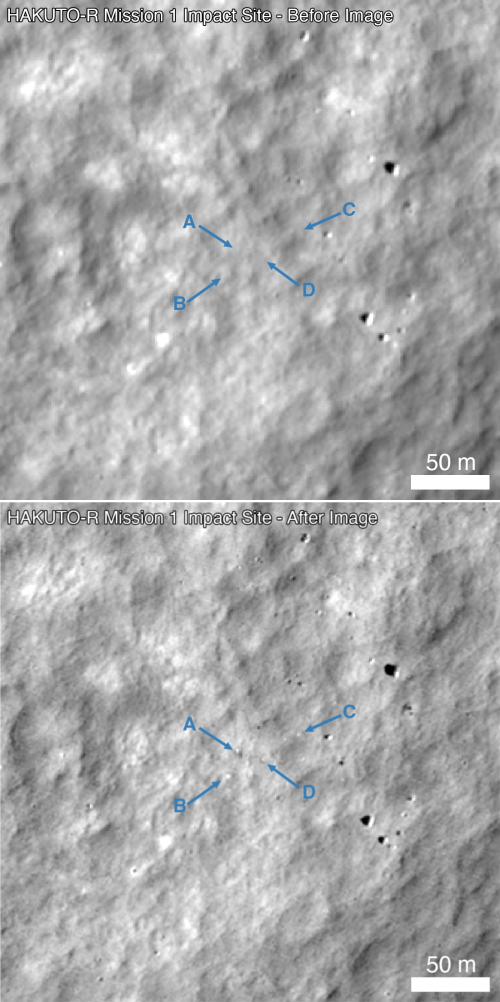
Click for original blink image.
NASA’s Lunar Reconnaissance Orbiter (LRO), scientists have spotted what they think is the impact debris produced when Ispace’s private lunar lander Hakuto-R1 crashed on the Moon on April 25, 2023.
To the right are two LRO images, the first at the top taken prior to Hakuto-R1’s landing attempt. The second at the bottom was acquired by LRO on April 26, 2023, the day after that attempt. The lettered arrows indicate four spots where the scientists identified changes between the two pictures. From the caption:
Arrow A points to a prominent surface change with higher reflectance in the upper left and lower reflectance in the lower right (opposite of nearby surface rocks along the right side of the frame). Arrows B-D point to other changes around the impact site.
According to the LRO science team, these changes suggest different pieces of debris, though it will take more analysis and more images under different lighting conditions to determine more precisely what they have found.
The presence however of four pieces strongly suggests that Hakuto-R1 hit the ground hard enough to break apart. Based on the initial data received during landing, it was thought the spacecraft had touched down softly but then was damaged by some unforeseen obstacle on the ground, such as a large boulder. The LRO image suggests instead that it did not touch down softly at all.

Click for original blink image.
NASA’s Lunar Reconnaissance Orbiter (LRO), scientists have spotted what they think is the impact debris produced when Ispace’s private lunar lander Hakuto-R1 crashed on the Moon on April 25, 2023.
To the right are two LRO images, the first at the top taken prior to Hakuto-R1’s landing attempt. The second at the bottom was acquired by LRO on April 26, 2023, the day after that attempt. The lettered arrows indicate four spots where the scientists identified changes between the two pictures. From the caption:
Arrow A points to a prominent surface change with higher reflectance in the upper left and lower reflectance in the lower right (opposite of nearby surface rocks along the right side of the frame). Arrows B-D point to other changes around the impact site.
According to the LRO science team, these changes suggest different pieces of debris, though it will take more analysis and more images under different lighting conditions to determine more precisely what they have found.
The presence however of four pieces strongly suggests that Hakuto-R1 hit the ground hard enough to break apart. Based on the initial data received during landing, it was thought the spacecraft had touched down softly but then was damaged by some unforeseen obstacle on the ground, such as a large boulder. The LRO image suggests instead that it did not touch down softly at all.
Leaving Earth: Space Stations, Rival Superpowers, and the Quest for Interplanetary Travel, can be purchased as an ebook everywhere for only $3.99 (before discount) at amazon, Barnes & Noble, all ebook vendors, or direct from my ebook publisher, ebookit.
If you buy it from ebookit you don't support the big oppressive tech companies and I get a bigger cut much sooner.
Winner of the 2003 Eugene M. Emme Award of the American Astronautical Society.
"Leaving Earth is one of the best and certainly the most comprehensive summary of our drive into space that I have ever read. It will be invaluable to future scholars because it will tell them how the next chapter of human history opened." -- Arthur C. Clarke
Air Force awards Ursa Major rocket engine development contact
The Air Force Research Laboratory (AFRL) has awarded the rocket engine startup Ursa Major a contract to develop two different rocket engines.
Under the contract, the Colorado-based firm will build and test a prototype of its new Draper engine for hypersonics, and further develop its 200,000-pound thrust Arroway engine for space launch.
…Under the AFRL contract, for which neither the lab or company provided a value, Ursa Major will also build a dedicated test stand for Draper and plans to hotfire the engine within 12 months.
Arroway, on the other hand, is a reusable liquid oxygen and methane staged combustion engine for medium and heavy launch vehicles. Ursa Major first announced development the 200,000-pound thrust engine last August, explaining that when clustered together, Arroway engines could replace the Russian-made RD-180 and RD-181, which are no longer available to US launch firms.
According to Ursa Major’s press release, the AFRL contract will allow further development of Arroway with a hotfire expected in 2025.
Ursa Major already has several contracts for its smaller Hadley engine, from the rocket startups Phantom, Vector, Astra, and the Air Force, and has built more than a hundred so far. The Arroway meanwhile is being developed as an American replacement for the Russian engines used by Northrop Grumman in its Antares rocket.
All in all, it appears Ursa Major is becoming a major challenger to Aerojet Rocketdyne, which in recent years had a lock on most government contracts for rocket engines. That lock resulted in very expensive engines that took years to build. The government (and others) are now finding someone else to provide this service at a better cost and far more quickly. We shall see whether Aerojet Rocketdyne responds to this competition properly, or goes the way of the horse carriage.
The Air Force Research Laboratory (AFRL) has awarded the rocket engine startup Ursa Major a contract to develop two different rocket engines.
Under the contract, the Colorado-based firm will build and test a prototype of its new Draper engine for hypersonics, and further develop its 200,000-pound thrust Arroway engine for space launch.
…Under the AFRL contract, for which neither the lab or company provided a value, Ursa Major will also build a dedicated test stand for Draper and plans to hotfire the engine within 12 months.
Arroway, on the other hand, is a reusable liquid oxygen and methane staged combustion engine for medium and heavy launch vehicles. Ursa Major first announced development the 200,000-pound thrust engine last August, explaining that when clustered together, Arroway engines could replace the Russian-made RD-180 and RD-181, which are no longer available to US launch firms.
According to Ursa Major’s press release, the AFRL contract will allow further development of Arroway with a hotfire expected in 2025.
Ursa Major already has several contracts for its smaller Hadley engine, from the rocket startups Phantom, Vector, Astra, and the Air Force, and has built more than a hundred so far. The Arroway meanwhile is being developed as an American replacement for the Russian engines used by Northrop Grumman in its Antares rocket.
All in all, it appears Ursa Major is becoming a major challenger to Aerojet Rocketdyne, which in recent years had a lock on most government contracts for rocket engines. That lock resulted in very expensive engines that took years to build. The government (and others) are now finding someone else to provide this service at a better cost and far more quickly. We shall see whether Aerojet Rocketdyne responds to this competition properly, or goes the way of the horse carriage.
SpaceX files to join FAA as defendant in lawsuit trying to shut down Boca Chica
SpaceX on May 19, 2023 submitted a motion to become a defendant in the lawsuit filed by the Center for Biological Diversity (CBD) and others that demands its Starship/Superheavy launchsite at Boca Chica be shut down.
“SpaceX’s Starship/Super Heavy launch program hinges on the FAA’s review and licensing decision challenged here. If the Court were to rule in Plaintiffs’ favor, the FAA’s decision could be set aside, and further licensing of the Starship/Super Heavy Program could be significantly delayed, causing severe injury to SpaceX’s business,” the company said in the motion, which was filed on May 19.
The full motion can be read here [pdf].
SpaceX’s motion notes that it has followed all government regulations in the decade since it established its Boca Chica launch site, and invested more than $3 billion in doing so. The motion points out that “the FAA does not adequately represent SpaceX’s interests” and that the company must participate because the lawsuit will have direct financial impact on its business.
In other words, the big guns are now being hauled out against this lawsuit, which on its face is somewhat weak. We shall see if it can withstand the much more aggressive fight that SpaceX is certain to put up.
SpaceX on May 19, 2023 submitted a motion to become a defendant in the lawsuit filed by the Center for Biological Diversity (CBD) and others that demands its Starship/Superheavy launchsite at Boca Chica be shut down.
“SpaceX’s Starship/Super Heavy launch program hinges on the FAA’s review and licensing decision challenged here. If the Court were to rule in Plaintiffs’ favor, the FAA’s decision could be set aside, and further licensing of the Starship/Super Heavy Program could be significantly delayed, causing severe injury to SpaceX’s business,” the company said in the motion, which was filed on May 19.
The full motion can be read here [pdf].
SpaceX’s motion notes that it has followed all government regulations in the decade since it established its Boca Chica launch site, and invested more than $3 billion in doing so. The motion points out that “the FAA does not adequately represent SpaceX’s interests” and that the company must participate because the lawsuit will have direct financial impact on its business.
In other words, the big guns are now being hauled out against this lawsuit, which on its face is somewhat weak. We shall see if it can withstand the much more aggressive fight that SpaceX is certain to put up.
Dido – White Flag
May 22, 2023 Quick space links
Courtesy of BtB’s stringer Jay.
- China’s Xichang spaceport brags that it had in 2022 zero injuries or casualties from rocket debris falling
This is one of China’s interior spaceports, so they apparently recognize that their rocket stages can fall on someone’s head, and are proud that in 2022 they avoided any such tragedies. Well, bully for them.
- Data from China’s Mars rover Zhurong suggests there was an ancient ocean once at its landing zone
The fundamental question remains: How could liquid water have been there in a climate that is too cold and an atmosphere too thin?
- India confirms it will launch Chandrayaan-3 to the Moon on July 12, 2023
The landing date near the south pole will be August 23, 2023.
- India targets May 29, 2023 for the next launch of its large GSLV rocket
It will place a GPS-type satellite into oribt.
Courtesy of BtB’s stringer Jay.
- China’s Xichang spaceport brags that it had in 2022 zero injuries or casualties from rocket debris falling
This is one of China’s interior spaceports, so they apparently recognize that their rocket stages can fall on someone’s head, and are proud that in 2022 they avoided any such tragedies. Well, bully for them.
- Data from China’s Mars rover Zhurong suggests there was an ancient ocean once at its landing zone
The fundamental question remains: How could liquid water have been there in a climate that is too cold and an atmosphere too thin?
- India confirms it will launch Chandrayaan-3 to the Moon on July 12, 2023
The landing date near the south pole will be August 23, 2023.
- India targets May 29, 2023 for the next launch of its large GSLV rocket
It will place a GPS-type satellite into oribt.
Pushback: California loses big for trying to force churches to violate their religious beliefs

Mary Watanaba, head oppressor
in California’s health system
They’re coming for you next: After California health authorities in 2014 imposed a mandate requiring requiring churches to provide elective abortion coverage to its employees, four churches sued, and after a long court battle, have now won a $1.4 million settlement.
Alliance Defending Freedom [ADF] attorneys represent Skyline Wesleyan Church, located in the San Diego area, in one federal lawsuit, and Foothill Church in Glendora, Calvary Chapel Chino Hills in Chino, and The Shepherd of the Hills Church in Porter Ranch in another. Both lawsuits challenged California’s abortion-coverage mandate. In both cases, the courts ruled that the U.S. Constitution protects the churches’ freedom to operate according to their religious beliefs, which include their belief in the sanctity of unborn lives.
The rulings in both lawsuits (here and here [pdfs]) not only release the churches from the illegal abortion mandate, they both require payments to ADF and the church’s local attorneys to pay all legal costs. Interesting, in both lawsuits Mary Watanabe, the director of the California Department of Managed Health Care (DMHC) was named, and in one case she was the only defendant. Unfortunately, she walks away unharmed, because DMHC will pay for everything, out of tax dollars.
What made the mandate especially egregious is that it was written in league with officials at Planned Parenthood and the ACLU, as shown by emails [pdf] between DMHC and those officials. » Read more

Mary Watanaba, head oppressor
in California’s health system
They’re coming for you next: After California health authorities in 2014 imposed a mandate requiring requiring churches to provide elective abortion coverage to its employees, four churches sued, and after a long court battle, have now won a $1.4 million settlement.
Alliance Defending Freedom [ADF] attorneys represent Skyline Wesleyan Church, located in the San Diego area, in one federal lawsuit, and Foothill Church in Glendora, Calvary Chapel Chino Hills in Chino, and The Shepherd of the Hills Church in Porter Ranch in another. Both lawsuits challenged California’s abortion-coverage mandate. In both cases, the courts ruled that the U.S. Constitution protects the churches’ freedom to operate according to their religious beliefs, which include their belief in the sanctity of unborn lives.
The rulings in both lawsuits (here and here [pdfs]) not only release the churches from the illegal abortion mandate, they both require payments to ADF and the church’s local attorneys to pay all legal costs. Interesting, in both lawsuits Mary Watanabe, the director of the California Department of Managed Health Care (DMHC) was named, and in one case she was the only defendant. Unfortunately, she walks away unharmed, because DMHC will pay for everything, out of tax dollars.
What made the mandate especially egregious is that it was written in league with officials at Planned Parenthood and the ACLU, as shown by emails [pdf] between DMHC and those officials. » Read more
Ancient volcano vent in the Martian southern cratered highlands?
The nature of today’s cool image suggests both ancient and more recent geological activity, each coming from entirely different sources but both helping to shape the alien Martian surface.
The picture to the right, rotated, cropped, reduced, and sharpened to post here, was taken on March 13, 2023 by the high resolution camera on Mars Reconnaissance Orbiter (MRO). It shows what the science team has labeled an “elongated depression,” sitting in the middle of a relatively flat but very rough stippled circular plain about 60 miles in diameter. An MRO context camera picture, taken on February 19, 2012, covered the central strip of this plain, and shows that its surface is equally rough and stippled everywhere, with only a few craters and one or two slight changes in elevation.
So, how does this feature tell us both about the ancient and recent geological history of this spot on Mars?
» Read more
The nature of today’s cool image suggests both ancient and more recent geological activity, each coming from entirely different sources but both helping to shape the alien Martian surface.
The picture to the right, rotated, cropped, reduced, and sharpened to post here, was taken on March 13, 2023 by the high resolution camera on Mars Reconnaissance Orbiter (MRO). It shows what the science team has labeled an “elongated depression,” sitting in the middle of a relatively flat but very rough stippled circular plain about 60 miles in diameter. An MRO context camera picture, taken on February 19, 2012, covered the central strip of this plain, and shows that its surface is equally rough and stippled everywhere, with only a few craters and one or two slight changes in elevation.
So, how does this feature tell us both about the ancient and recent geological history of this spot on Mars?
» Read more
Jellyfish galaxy plowing its way through the intercluster medium
The European Space Agency (ESA) today released another in a series of images taken by the Hubble Space Telescope during the past two years of what astronomers call jellyfish galaxies, so named because such galaxies have tendrils that extend out beyond the galaxy like the tendrils of jellyfish. This new picture is to the right, cropped, reduced, and sharpened to post here, and shows a galaxy about 900 million light years away.
[T]he space between galaxies in a cluster is … pervaded with a searingly hot plasma known as the intracluster medium. While this plasma is extremely tenuous, galaxies moving through it experience it almost like swimmers fighting against a current, and this interaction can strip galaxies of their star-forming gas. This interaction between the intracluster medium and the galaxies is called ram-pressure stripping, and is the process responsible for the trailing tendrils of this jellyfish galaxy.
The arrow in the image indicates the galaxy’s direction of travel through the intercluster medium, resulting in the outer parts of the leading arm to be pushed backward above the galaxy, while material at its rear trail behind. Note also the blue star-forming regions at the galaxy’s bow. The ram pressure is also apparently causing more star formation in this part of the galaxy compared to elsewhere.
The European Space Agency (ESA) today released another in a series of images taken by the Hubble Space Telescope during the past two years of what astronomers call jellyfish galaxies, so named because such galaxies have tendrils that extend out beyond the galaxy like the tendrils of jellyfish. This new picture is to the right, cropped, reduced, and sharpened to post here, and shows a galaxy about 900 million light years away.
[T]he space between galaxies in a cluster is … pervaded with a searingly hot plasma known as the intracluster medium. While this plasma is extremely tenuous, galaxies moving through it experience it almost like swimmers fighting against a current, and this interaction can strip galaxies of their star-forming gas. This interaction between the intracluster medium and the galaxies is called ram-pressure stripping, and is the process responsible for the trailing tendrils of this jellyfish galaxy.
The arrow in the image indicates the galaxy’s direction of travel through the intercluster medium, resulting in the outer parts of the leading arm to be pushed backward above the galaxy, while material at its rear trail behind. Note also the blue star-forming regions at the galaxy’s bow. The ram pressure is also apparently causing more star formation in this part of the galaxy compared to elsewhere.
Three government agencies now investigating the safety of methane-fueled rockets
We’re here to help you! It appears that three different federal agencies have been tasked to investigate the safety of methane-fueled rockets, which SpaceX, Relativity, Blue Origin, and others are beginning to use for their rockets. It burns cleaner and with more power than kerosene and is easier to handle than hydrogen.
Yet, the federal government under Biden now seems worried a new innovation in rocketry is being developed. First, the FAA is studying the explosive potential of such rockets, according to Brian Rushforth, the manager of the innovation division.
The FAA has set up a test stand at the Dugway Proving Ground in Utah. A crane 43 meters tall will be used to drop stainless steel containers containing mixtures of LOX and methane. A series of tests is planned to start in June on three-week intervals to measure the explosive power of that propellant combination. A second phase, tentatively scheduled for next year, will conduct similar tests with varying velocities. He said the data from those tests will be shared with other government agencies, such as NASA and the U.S. Space Force, along with launch vehicle developers.
Meanwhile, NASA and the Space Force are jointly doing a separate study on how methane-fueled rockets threaten the launch range and other nearby launchpads.
In all three cases it can be argued that these studies make sense. It also can be argued that the Biden administration is putting pressure on these agencies to find ways to squelch this new technology, especially because it is central to the development of SpaceX’s Superheavy/Starship rocket, and there is real hostility in Democrat/leftist circles to Elon Musk. This latter argument is further strengthened when you consider the explosive possibilities of hydrogen fuel, used by the space shuttle for decades as well as NASA’s SLS rocket. I can’t imagine its danger is less than methane. If hydrogen has been determined to be okay why should methane now be considered a threat?
Either way, we can be sure of one thing: These studies will slow down development by SpaceX and others of these new methane-fueled rockets. They will also provide ammunition for outside environmental groups who want to file further lawsuits against these companies to stop their rockets from launching.
We’re here to help you! It appears that three different federal agencies have been tasked to investigate the safety of methane-fueled rockets, which SpaceX, Relativity, Blue Origin, and others are beginning to use for their rockets. It burns cleaner and with more power than kerosene and is easier to handle than hydrogen.
Yet, the federal government under Biden now seems worried a new innovation in rocketry is being developed. First, the FAA is studying the explosive potential of such rockets, according to Brian Rushforth, the manager of the innovation division.
The FAA has set up a test stand at the Dugway Proving Ground in Utah. A crane 43 meters tall will be used to drop stainless steel containers containing mixtures of LOX and methane. A series of tests is planned to start in June on three-week intervals to measure the explosive power of that propellant combination. A second phase, tentatively scheduled for next year, will conduct similar tests with varying velocities. He said the data from those tests will be shared with other government agencies, such as NASA and the U.S. Space Force, along with launch vehicle developers.
Meanwhile, NASA and the Space Force are jointly doing a separate study on how methane-fueled rockets threaten the launch range and other nearby launchpads.
In all three cases it can be argued that these studies make sense. It also can be argued that the Biden administration is putting pressure on these agencies to find ways to squelch this new technology, especially because it is central to the development of SpaceX’s Superheavy/Starship rocket, and there is real hostility in Democrat/leftist circles to Elon Musk. This latter argument is further strengthened when you consider the explosive possibilities of hydrogen fuel, used by the space shuttle for decades as well as NASA’s SLS rocket. I can’t imagine its danger is less than methane. If hydrogen has been determined to be okay why should methane now be considered a threat?
Either way, we can be sure of one thing: These studies will slow down development by SpaceX and others of these new methane-fueled rockets. They will also provide ammunition for outside environmental groups who want to file further lawsuits against these companies to stop their rockets from launching.
Indian company joins the high altitude balloon tourist race
A new company from India, Space Aura, is proposing to fly tourists on a high altitude balloon by 2025, joining the global competition that already includes two American balloon companies as well as one Spanish company.
Space Aura’s capsule, christened prototype SKAP1, will be tethered to a high performance ‘space balloon system’, complete with an enormous parachute. The capsule will accommodate six tourists and one pilot with ample leg room and comfortable walking space. It will be pressurised during flight and will have environmental control and life support systems that maintain oxygen, pressure, and temperature levels.
Even though passengers will not experience microgravity, they would still need to prepare before flying. Prior to the launch, which will be from Karnataka, Maharashtra, or Madhya Pradesh, the group of space tourists will undergo a week of basic physical training. The duration of the entire flight is expected to be about 5.5 to 6 hours. Tourists will ascend for about 90 minutes, spend an hour gazing out at the earth below, and begin their 90-minute descent with the balloon and parachute.
The two American companies, Space Perspective and World View, claim they will be flying tourists by 2024, while the Spanish company, Halo Space, is targeting 2025.
A new company from India, Space Aura, is proposing to fly tourists on a high altitude balloon by 2025, joining the global competition that already includes two American balloon companies as well as one Spanish company.
Space Aura’s capsule, christened prototype SKAP1, will be tethered to a high performance ‘space balloon system’, complete with an enormous parachute. The capsule will accommodate six tourists and one pilot with ample leg room and comfortable walking space. It will be pressurised during flight and will have environmental control and life support systems that maintain oxygen, pressure, and temperature levels.
Even though passengers will not experience microgravity, they would still need to prepare before flying. Prior to the launch, which will be from Karnataka, Maharashtra, or Madhya Pradesh, the group of space tourists will undergo a week of basic physical training. The duration of the entire flight is expected to be about 5.5 to 6 hours. Tourists will ascend for about 90 minutes, spend an hour gazing out at the earth below, and begin their 90-minute descent with the balloon and parachute.
The two American companies, Space Perspective and World View, claim they will be flying tourists by 2024, while the Spanish company, Halo Space, is targeting 2025.
China launches two satellites yesterday, one for Macau
China yesterday used its Long March 2C rocket to launch two satellites into orbit, with one the first science satellite by Macau, designed to study the Earth’s magnetic field in conjunction with other satellites already in orbit.
No information that I could find was released about the second satellite. The launch, from China’s interior Jiuquan spaceport, dropped the rocket’s first stage somewhere in China. No word on whether it landed near habitable areas.
The leaders in the 2023 launch race:
34 SpaceX
19 China
6 Russia
4 Rocket Lab (with a launch scheduled for tomorrow)
American private enterprise still leads China 38 to 19 in the national rankings, and the entire world combined 38 to 31. SpaceX by itself now tied trails in total launches with the rest of the world, including American companies, 34 to 35.
China yesterday used its Long March 2C rocket to launch two satellites into orbit, with one the first science satellite by Macau, designed to study the Earth’s magnetic field in conjunction with other satellites already in orbit.
No information that I could find was released about the second satellite. The launch, from China’s interior Jiuquan spaceport, dropped the rocket’s first stage somewhere in China. No word on whether it landed near habitable areas.
The leaders in the 2023 launch race:
34 SpaceX
19 China
6 Russia
4 Rocket Lab (with a launch scheduled for tomorrow)
American private enterprise still leads China 38 to 19 in the national rankings, and the entire world combined 38 to 31. SpaceX by itself now tied trails in total launches with the rest of the world, including American companies, 34 to 35.
SpaceX launches Axiom’s second commercial manned mission to ISS
SpaceX today successfully used its Falcon 9 rocket to launch its Freedom manned capsule on its second flight, carrying four passengers on Axiom’s second commercial manned mission to ISS.
The Axiom crew included three paying passengers, one from the U.S. and two from Saudi Arabia, with the fourth crew member former NASA astronaut Peggy Whitson, now acting as Axiom’s commander. They plan to spend eight days docked to ISS. Making this commercial flight even more interesting is that the station already has a Middle Eastern commercial astronaut, from the United Arab Emirates. The Arab space race is clearing heating up.
The first stage was making its first flight, and successfully landed back at Cape Canaveral.
Were you aware this was happening? With my readers I expect so, but I am willing to bet that we are a very small minority. SpaceX has now made American manned spaceflight so routine almost no one pays attention.
The leaders in the 2023 launch race:
34 SpaceX
18 China
6 Russia
4 Rocket Lab
American private enterprise now leads China 38 to 18 in the national rankings, and the entire world combined 38 to 30. SpaceX by itself is now tied in total launches with the rest of the world, including American companies.
SpaceX today successfully used its Falcon 9 rocket to launch its Freedom manned capsule on its second flight, carrying four passengers on Axiom’s second commercial manned mission to ISS.
The Axiom crew included three paying passengers, one from the U.S. and two from Saudi Arabia, with the fourth crew member former NASA astronaut Peggy Whitson, now acting as Axiom’s commander. They plan to spend eight days docked to ISS. Making this commercial flight even more interesting is that the station already has a Middle Eastern commercial astronaut, from the United Arab Emirates. The Arab space race is clearing heating up.
The first stage was making its first flight, and successfully landed back at Cape Canaveral.
Were you aware this was happening? With my readers I expect so, but I am willing to bet that we are a very small minority. SpaceX has now made American manned spaceflight so routine almost no one pays attention.
The leaders in the 2023 launch race:
34 SpaceX
18 China
6 Russia
4 Rocket Lab
American private enterprise now leads China 38 to 18 in the national rankings, and the entire world combined 38 to 30. SpaceX by itself is now tied in total launches with the rest of the world, including American companies.
SpaceX launches 5 Iridium and 16 OneWeb satellites
SpaceX early today successfully used its Falcon 9 rocket to put five Iridium and sixteen OneWeb satellites into orbit, lifting off from Vandenberg Space Force Base.
The first stage successfully completed its eleventh flight, landing on a drone ship in the Pacific. The two fairings completed their third and sixth flights respectively.
The leaders in the 2023 launch race:
33 SpaceX (with a launch scheduled for tomorrow)
18 China
6 Russia
4 Rocket Lab (with a launch scheduled for tomorrow)
American private enterprise now leads China 37 to 18 in the national rankings, and the entire world combined 37 to 30. SpaceX now trails the entire world combined, including American companies, by only 33 to 34.
SpaceX early today successfully used its Falcon 9 rocket to put five Iridium and sixteen OneWeb satellites into orbit, lifting off from Vandenberg Space Force Base.
The first stage successfully completed its eleventh flight, landing on a drone ship in the Pacific. The two fairings completed their third and sixth flights respectively.
The leaders in the 2023 launch race:
33 SpaceX (with a launch scheduled for tomorrow)
18 China
6 Russia
4 Rocket Lab (with a launch scheduled for tomorrow)
American private enterprise now leads China 37 to 18 in the national rankings, and the entire world combined 37 to 30. SpaceX now trails the entire world combined, including American companies, by only 33 to 34.
May 19, 2023 Zimmerman/Batchelor podcast
Embedded below the fold in two parts.
To listen to all of John Batchelor’s podcasts, go here.
» Read more
Embedded below the fold in two parts.
To listen to all of John Batchelor’s podcasts, go here.
» Read more
Don McMillan – Comedy for scientists
An evening pause: I wonder how many of my readers will get that last joke.
Hat tip Tom Biggar. And a great weekend to all.
May 19, 2023 Quick space links
Courtesy of BtB’s stringer Jay.
- Australian company gets deal to develop technique with American company for using space junk for fuel
The press release [pdf] provides more details.
- Australian company gets approval to develop site for producing solid fuel and launching rockets
The company, Black Sky, appears a long way from actual launches.
- Video showing how equipment is moved from inside China’s Tiangong-3 station to outside without an astronaut EVA
Essentially they put the gear in the airlock, and then the robot arm, operated by an astronaut, pulls it out. From there however a spacewalk is usually required to install the gear, depending on what it is.
- Video taken by nearby bystanders of Long March 3B launch
“Nearby” is an understatement, especially considering this is a rocket using toxic hypergolic fuel. The videographer couldn’t have been more than a half mile away, and maybe as close as a quarter of a mile.
- FCC rules against Dish Network’s 5G plan, claiming it would interfere with Starlink
This decision illustrates the critical importance of acting fast in a competitive market. SpaceX moves fast, gets launched first, and thus automatically gets priority when conflicts occur with other systems that are only proposed.
- Space Perspective will offer high altitude balloon weddings in late 2024
Ticket prices will start at $125K per person.
- Russia and Uganda sign deal not to deploy weapons in space
This agreement, like the Biden administration’s call for a similar ban, is worthless. When it comes time that someone wants to use force in space, force will be used, whether morally right or not. And the victim will have no choice but to respond in kind. That simply is the way of all things.
Courtesy of BtB’s stringer Jay.
- Australian company gets deal to develop technique with American company for using space junk for fuel
The press release [pdf] provides more details.
- Australian company gets approval to develop site for producing solid fuel and launching rockets
The company, Black Sky, appears a long way from actual launches.
- Video showing how equipment is moved from inside China’s Tiangong-3 station to outside without an astronaut EVA
Essentially they put the gear in the airlock, and then the robot arm, operated by an astronaut, pulls it out. From there however a spacewalk is usually required to install the gear, depending on what it is.
- Video taken by nearby bystanders of Long March 3B launch
“Nearby” is an understatement, especially considering this is a rocket using toxic hypergolic fuel. The videographer couldn’t have been more than a half mile away, and maybe as close as a quarter of a mile.
- FCC rules against Dish Network’s 5G plan, claiming it would interfere with Starlink
This decision illustrates the critical importance of acting fast in a competitive market. SpaceX moves fast, gets launched first, and thus automatically gets priority when conflicts occur with other systems that are only proposed.
- Space Perspective will offer high altitude balloon weddings in late 2024
Ticket prices will start at $125K per person.
- Russia and Uganda sign deal not to deploy weapons in space
This agreement, like the Biden administration’s call for a similar ban, is worthless. When it comes time that someone wants to use force in space, force will be used, whether morally right or not. And the victim will have no choice but to respond in kind. That simply is the way of all things.
Buried dying glacier in the Martian dry equatorial regions?
Today’s cool image from Mars is not so much unique visually as it is unique in terms of its location. The picture to the right, rotated, cropped, reduced, and sharpened to post here, was taken on January 31, 2023 by the high resolution camera on Mars Reconnaissance Orbiter (MRO). It shows the northern rim of a small crater, with its floor filled with an intriguing mound of material.
The picture was labeled a “terrain sample”, which suggests it wasn’t taken as part of any specific research project by instead to fill a gap in the camera’s schedule. To maintain the camera’s proper temperature, it is necessary to take pictures regularly, and when the camera team finds a gap that is too long, they fill it by choosing some almost random target in that gap that might be interesting. Sometimes it is, sometimes not.
In this case I strongly suspect this target was hardly random. The picture title also mentions MRO’s now retired radar CRISM instrument, which was used to detect evidence of underground ice. My guess is that the camera team thus likely decided to image this crater in high resolution because that radar data suggested the presence of underground ice.
This guess is strongly confirmed by a context camera picture taken of this crater on September 1, 2008. The crater appears surrounded by the typical splash apron one routinely sees around impact craters in the mid- and high-latitude northern lowland plains, where there is a lot of near surface ice.
The bumpy mound seen in high resolution on the floor of this crater could very well be buried glacial ice, as it mimics similar features in the many craters in the mid-latitudes of Mars. But is it buried ice? The location says otherwise.
» Read more
Today’s cool image from Mars is not so much unique visually as it is unique in terms of its location. The picture to the right, rotated, cropped, reduced, and sharpened to post here, was taken on January 31, 2023 by the high resolution camera on Mars Reconnaissance Orbiter (MRO). It shows the northern rim of a small crater, with its floor filled with an intriguing mound of material.
The picture was labeled a “terrain sample”, which suggests it wasn’t taken as part of any specific research project by instead to fill a gap in the camera’s schedule. To maintain the camera’s proper temperature, it is necessary to take pictures regularly, and when the camera team finds a gap that is too long, they fill it by choosing some almost random target in that gap that might be interesting. Sometimes it is, sometimes not.
In this case I strongly suspect this target was hardly random. The picture title also mentions MRO’s now retired radar CRISM instrument, which was used to detect evidence of underground ice. My guess is that the camera team thus likely decided to image this crater in high resolution because that radar data suggested the presence of underground ice.
This guess is strongly confirmed by a context camera picture taken of this crater on September 1, 2008. The crater appears surrounded by the typical splash apron one routinely sees around impact craters in the mid- and high-latitude northern lowland plains, where there is a lot of near surface ice.
The bumpy mound seen in high resolution on the floor of this crater could very well be buried glacial ice, as it mimics similar features in the many craters in the mid-latitudes of Mars. But is it buried ice? The location says otherwise.
» Read more
Pushback: Arizona drops trespassing charges against student for handing out the Constitution at Arizona State U
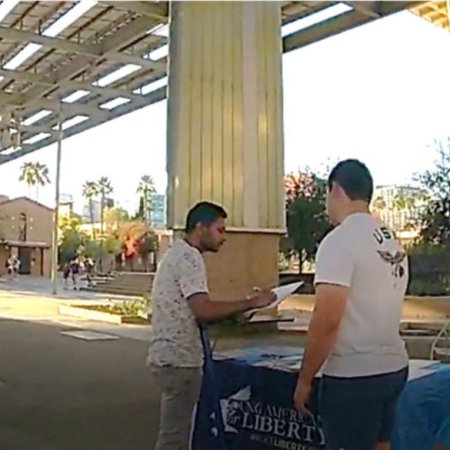
Tim Tizon (r) discussing free speech with another student on
March 3, 2022 at that banned YAL table on the ASU campus.
They’re coming for you next: Today’s story is a followup of a February blacklist story. Tim Tizon, a Arizona State University (ASU) student at the time of the incident in March 2022, had been charged with trespass by the university when he set up a Young Americans for Liberty (YAL) table on campus to hand out free copies of the U.S. Constitution.
The location was a designated space for free speech and had not been reserved by anyone. His table was not blocking anything, as numerous witness testified. Yet, school officials showed up and demanded he leave, moving his table to a remote part of the campus where no one would see it. Apparently, Arizona State University officials were uncomfortable with the ideals of freedom and law as stated by Constitution and the Bill of Rights.
Tizon however refused to move, and was charged with trespass, convicted, and sentenced to a fine $300 plus fifteen hours of community service.
» Read more

Tim Tizon (r) discussing free speech with another student on
March 3, 2022 at that banned YAL table on the ASU campus.
They’re coming for you next: Today’s story is a followup of a February blacklist story. Tim Tizon, a Arizona State University (ASU) student at the time of the incident in March 2022, had been charged with trespass by the university when he set up a Young Americans for Liberty (YAL) table on campus to hand out free copies of the U.S. Constitution.
The location was a designated space for free speech and had not been reserved by anyone. His table was not blocking anything, as numerous witness testified. Yet, school officials showed up and demanded he leave, moving his table to a remote part of the campus where no one would see it. Apparently, Arizona State University officials were uncomfortable with the ideals of freedom and law as stated by Constitution and the Bill of Rights.
Tizon however refused to move, and was charged with trespass, convicted, and sentenced to a fine $300 plus fifteen hours of community service.
» Read more
Starship prototype #25 is rolled to launchpad for static fire engine tests
SpaceX yesterday evening rolled its 25th prototype of its Starship spacecraft to its suborbital launchpad at Boca Chica, as shown on the image to the right, for a planned static fire engine test of its six Raptor engines.
If all goes well, the company hopes to stack this prototype on top of the ninth prototype of Superheavy and complete the second test orbital flight of the entire rocket as early as June 15, 2023, with a launch window as long as six months according to the company’s FCC communications license application.
The actual launch date however remains very uncertain, for several reasons. The FAA must issue a launch license, and it won’t do that until it is satisfied the investigation into the first launch failure is complete. That launch approval will also likely be delayed because of the lawsuit against that agency for issuing the previous launch license.
SpaceX yesterday evening rolled its 25th prototype of its Starship spacecraft to its suborbital launchpad at Boca Chica, as shown on the image to the right, for a planned static fire engine test of its six Raptor engines.
If all goes well, the company hopes to stack this prototype on top of the ninth prototype of Superheavy and complete the second test orbital flight of the entire rocket as early as June 15, 2023, with a launch window as long as six months according to the company’s FCC communications license application.
The actual launch date however remains very uncertain, for several reasons. The FAA must issue a launch license, and it won’t do that until it is satisfied the investigation into the first launch failure is complete. That launch approval will also likely be delayed because of the lawsuit against that agency for issuing the previous launch license.
Capstone does lunar fly-by, takes first lunar pictures, completes main mission
The smallsat engineering test lunar orbiter Capstone has now successfully ended its primary mission, completing six months of operation in the near-rectilinear halo orbit that NASA’s Lunar Gateway manned space station intends to fly.
To put a final touch on that main mission, in May mission managers at the private company Advanced Space also completed two additional experiments. On May 3, 2023 they performed a close-fly of the Moon, using the spacecraft’s camera for the first time to take the picture of the Moon to the right.
Then, on May 9 Capstone successfully tested navigation technology in conjunction with NASA’s Lunar Reconnaissance Orbiter (LRO), also in orbit around the Moon.
During the May 9 experiment, CAPSTONE sent a signal to LRO designed to measure the distance and relative velocity between the two spacecraft. LRO then returned the signal to CAPSTONE, where it was converted into a measurement. The test proved the ability to collect measurements that will be utilized by CAPS software to determine the positioning of both spacecraft. This capability could provide autonomous onboard navigation information for future lunar missions.
The mission now enters its extended mission, planned to last at least a year.
The smallsat engineering test lunar orbiter Capstone has now successfully ended its primary mission, completing six months of operation in the near-rectilinear halo orbit that NASA’s Lunar Gateway manned space station intends to fly.
To put a final touch on that main mission, in May mission managers at the private company Advanced Space also completed two additional experiments. On May 3, 2023 they performed a close-fly of the Moon, using the spacecraft’s camera for the first time to take the picture of the Moon to the right.
Then, on May 9 Capstone successfully tested navigation technology in conjunction with NASA’s Lunar Reconnaissance Orbiter (LRO), also in orbit around the Moon.
During the May 9 experiment, CAPSTONE sent a signal to LRO designed to measure the distance and relative velocity between the two spacecraft. LRO then returned the signal to CAPSTONE, where it was converted into a measurement. The test proved the ability to collect measurements that will be utilized by CAPS software to determine the positioning of both spacecraft. This capability could provide autonomous onboard navigation information for future lunar missions.
The mission now enters its extended mission, planned to last at least a year.
Lucy makes course correction in preparation for 1st asteroid fly-by
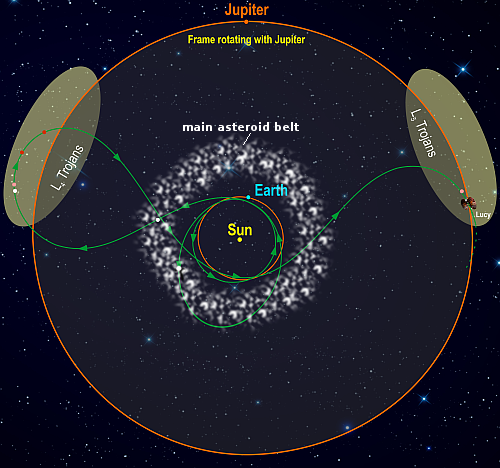
Lucy’s route through the solar system
The asteroid probe Lucy on May 9, 2023 fired its engines to successfully make a minor course correction in preparation for a fly by of the asteroid Dinkinesh, located in the main asteroid belt between Mars and Jupiter.
Even though the spacecraft is currently travelling at approximately 43,000 mph (19.4 km/s), this small nudge is enough to move the spacecraft nearly 40,000 miles (65,000 km) closer to the asteroid during the planned encounter on Nov. 1, 2023. The spacecraft will fly a mere 265 miles (425 km) from the small, half-mile- (sub-km)-sized asteroid, while travelling at a relative speed of 10,000 mph (4.5 km/s).
Dinkinesh, the white dot inside the main asteroid belt in the lower left of the map to the right, is the first of eight asteroids Lucy will fly past.

Lucy’s route through the solar system
The asteroid probe Lucy on May 9, 2023 fired its engines to successfully make a minor course correction in preparation for a fly by of the asteroid Dinkinesh, located in the main asteroid belt between Mars and Jupiter.
Even though the spacecraft is currently travelling at approximately 43,000 mph (19.4 km/s), this small nudge is enough to move the spacecraft nearly 40,000 miles (65,000 km) closer to the asteroid during the planned encounter on Nov. 1, 2023. The spacecraft will fly a mere 265 miles (425 km) from the small, half-mile- (sub-km)-sized asteroid, while travelling at a relative speed of 10,000 mph (4.5 km/s).
Dinkinesh, the white dot inside the main asteroid belt in the lower left of the map to the right, is the first of eight asteroids Lucy will fly past.
NASA picks Blue Origin’s partnership for building second manned lunar lander
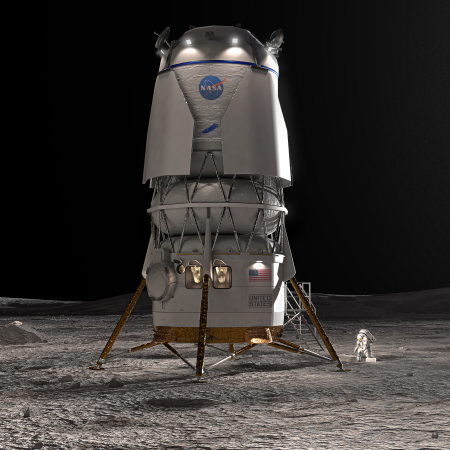
An artist’s concept of Blue Moon
NASA today announced that it has chosen the partnership led by Blue Origin to build a second manned lunar lander for its Artemis program.
Blue Origin will design, develop, test, and verify its Blue Moon lander to meet NASA’s human landing system requirements for recurring astronaut expeditions to the lunar surface, including docking with Gateway, a space station where crew transfer in lunar orbit. In addition to design and development work, the contract includes one uncrewed demonstration mission to the lunar surface before a crewed demo on the Artemis V mission in 2029. The total award value of the firm-fixed price contract is $3.4 billion.
The other partners in the contract are Draper, Astrobotic, and Honeybee Robotics.
This is NASA’s second contract for a lunar lander, with SpaceX’s Starship the first. The idea is to have two landers available from competing companies for both competition and redundancy, similar to the approach the agency has used for its manned ferry service to ISS, using SpaceX and Boeing. I wonder if NASA’s experience on the Moon will be similar to that ferry service, whereby only SpaceX so far has been able to deliver. The track record of Blue Origin suggests it will do about as poorly as Boeing has with Starliner.

An artist’s concept of Blue Moon
NASA today announced that it has chosen the partnership led by Blue Origin to build a second manned lunar lander for its Artemis program.
Blue Origin will design, develop, test, and verify its Blue Moon lander to meet NASA’s human landing system requirements for recurring astronaut expeditions to the lunar surface, including docking with Gateway, a space station where crew transfer in lunar orbit. In addition to design and development work, the contract includes one uncrewed demonstration mission to the lunar surface before a crewed demo on the Artemis V mission in 2029. The total award value of the firm-fixed price contract is $3.4 billion.
The other partners in the contract are Draper, Astrobotic, and Honeybee Robotics.
This is NASA’s second contract for a lunar lander, with SpaceX’s Starship the first. The idea is to have two landers available from competing companies for both competition and redundancy, similar to the approach the agency has used for its manned ferry service to ISS, using SpaceX and Boeing. I wonder if NASA’s experience on the Moon will be similar to that ferry service, whereby only SpaceX so far has been able to deliver. The track record of Blue Origin suggests it will do about as poorly as Boeing has with Starliner.
SpaceX launches another 22 upgraded Starlink satellites into orbit
Using its Falcon 9 rocket SpaceX early today successfully launched another 22 upgraded Starlink satellites into orbit, lifting off from Cape Canaveral.
The first stage completed its fifth flight, landing successfully on a drone ship in the Atlantic. The fairings completed their eighth flight.
The leaders in the 2023 launch race:
32 SpaceX
18 China
6 Russia
4 Rocket Lab
American private enterprise now leads China 36 to 18 in the national rankings, and the entire world combined 36 to 30. SpaceX by itself only trails the entire world combined, including American companies, 32 to 34.
Using its Falcon 9 rocket SpaceX early today successfully launched another 22 upgraded Starlink satellites into orbit, lifting off from Cape Canaveral.
The first stage completed its fifth flight, landing successfully on a drone ship in the Atlantic. The fairings completed their eighth flight.
The leaders in the 2023 launch race:
32 SpaceX
18 China
6 Russia
4 Rocket Lab
American private enterprise now leads China 36 to 18 in the national rankings, and the entire world combined 36 to 30. SpaceX by itself only trails the entire world combined, including American companies, 32 to 34.
Zbigniew Rybczyński – The Orchestra (final scene)
An evening pause: Music is of course Ravel’s Bolero. This provides us an elegant thumbnail history of the Soviet Union using dance, choreography, and clever filming. And it is honest, showing how the whole thing was run by gangstas, as all such top-down communist/socialist societies are, and as America is now adopting. More information about the entire work here.
Hat tip Dave McCooey.
The old blacklisting against Jews has now been enthusiastically renewed on American campuses

The goal of college diversity programs for Jews
They’re coming for you next: Rather than write a column today (I feel very burnt out by all that I read), I would instead like to point my readers to this detailed overview of the return of wide-spread and pervasive anti-Semitism at American universities, all under the guise of the “diversity, equity, and inclusion” (DEI) mantra, which in itself is merely a restatement of “critical race theory,” which is also merely a rewording of basic Marxist racism.
This quote sums the article up:
[T]he DEI regime is key to understanding the climate on college campuses for Jewish students. Our desire to quantify everything has led the network of Jewish advocacy groups in the United States to measure anti-Semitism by “incidents.” That is certainly part of it—but only part. It is unnerving to see a swastika or “from the river to the sea” scrawled in chalk on the sidewalk outside a campus Hillel. But what those incident reports don’t show are actions and thought leadership sometimes orders of magnitude more sinister.
In an atmosphere where DEI has great sway, merely to denounce anti-Semitic violence is to risk one’s job, reputation, career, livelihood. And to express one’s Judaism openly on college campuses in that atmosphere requires a dose of courage no one should be required to show just to live a day-to-day life. In 2021, the Louis D. Brandeis Center for Human Rights Under Law surveyed “openly Jewish” college students and found that nearly 70 percent “personally experienced or were familiar with an anti-Semitic attack in the past 120 days.” In addition, more than 65 percent “have felt unsafe on campus due to physical or verbal attacks, with one in 10 reporting they have feared they themselves would be physically attacked.” And, the Brandeis Center continues, roughly 50 percent “have felt the need to hide their Jewish identity.”
Of those who hid their identity on campus, 30 percent did so because they were worried about how their professors would treat them. And why wouldn’t they worry? George Washington University sided with the professor who harassed Jewish students and retaliated when they objected—all in the name of “diversity.”
The story recounts many examples of this kind of bigotry, all endorsed and even instigated by the diversity officers at the colleges, with many of those stories already specifically described by me in past blacklist columns. What makes this article useful is how it takes a wider view to clearly illustrate how the administrative culture of academia is now hand-in-glove with anti-Semitism, and is working hard to encourage it at all levels.

The goal of college diversity programs for Jews
They’re coming for you next: Rather than write a column today (I feel very burnt out by all that I read), I would instead like to point my readers to this detailed overview of the return of wide-spread and pervasive anti-Semitism at American universities, all under the guise of the “diversity, equity, and inclusion” (DEI) mantra, which in itself is merely a restatement of “critical race theory,” which is also merely a rewording of basic Marxist racism.
This quote sums the article up:
[T]he DEI regime is key to understanding the climate on college campuses for Jewish students. Our desire to quantify everything has led the network of Jewish advocacy groups in the United States to measure anti-Semitism by “incidents.” That is certainly part of it—but only part. It is unnerving to see a swastika or “from the river to the sea” scrawled in chalk on the sidewalk outside a campus Hillel. But what those incident reports don’t show are actions and thought leadership sometimes orders of magnitude more sinister.
In an atmosphere where DEI has great sway, merely to denounce anti-Semitic violence is to risk one’s job, reputation, career, livelihood. And to express one’s Judaism openly on college campuses in that atmosphere requires a dose of courage no one should be required to show just to live a day-to-day life. In 2021, the Louis D. Brandeis Center for Human Rights Under Law surveyed “openly Jewish” college students and found that nearly 70 percent “personally experienced or were familiar with an anti-Semitic attack in the past 120 days.” In addition, more than 65 percent “have felt unsafe on campus due to physical or verbal attacks, with one in 10 reporting they have feared they themselves would be physically attacked.” And, the Brandeis Center continues, roughly 50 percent “have felt the need to hide their Jewish identity.”
Of those who hid their identity on campus, 30 percent did so because they were worried about how their professors would treat them. And why wouldn’t they worry? George Washington University sided with the professor who harassed Jewish students and retaliated when they objected—all in the name of “diversity.”
The story recounts many examples of this kind of bigotry, all endorsed and even instigated by the diversity officers at the colleges, with many of those stories already specifically described by me in past blacklist columns. What makes this article useful is how it takes a wider view to clearly illustrate how the administrative culture of academia is now hand-in-glove with anti-Semitism, and is working hard to encourage it at all levels.





